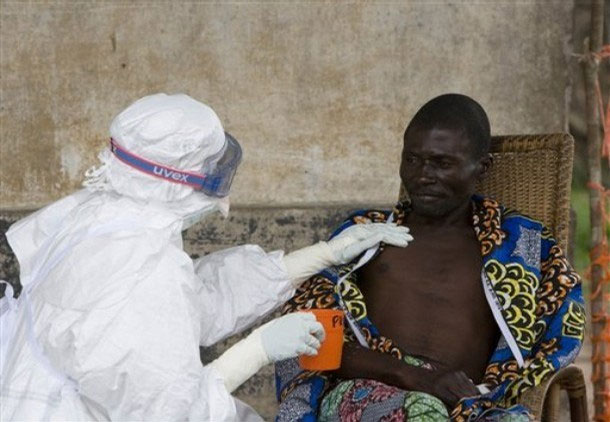MUST READ: Signs, symptoms and all there is to know: Ebola Virus Disease
- Posted on
- Comment
 Ebola virus disease (EVD) or Ebola hemorrhagic fever (EHF) is the human disease caused by the ebola virus. Symptoms typically start two days to three weeks after contracting the virus, with a fever, throat and muscle pains, and headaches. There is then typically nausea, vomiting, and diarrhea, along with decreased functioning of the liver and kidneys. At this point, some people begin to have problems with bleeding.
Ebola virus disease (EVD) or Ebola hemorrhagic fever (EHF) is the human disease caused by the ebola virus. Symptoms typically start two days to three weeks after contracting the virus, with a fever, throat and muscle pains, and headaches. There is then typically nausea, vomiting, and diarrhea, along with decreased functioning of the liver and kidneys. At this point, some people begin to have problems with bleeding.
The disease is usually acquired when a person comes into contact with the blood or bodily fluids of an infected animal such as a monkey or fruit bat. Fruit bats are believed to carry and spread the virus without being affected by it. Once infection of a human occurs, the disease may be spread from one person to another. Men who survive may be able to transmit the disease via their semenfor nearly two months. To make the diagnosis, typically other diseases with similar symptoms such as malaria, cholera and other viral hemorrhagic fever are first excluded. The blood may then be tested for antibodies to the virus, or the viral RNA, or the virus itself, to confirm the diagnosis.
Prevention includes decreasing the spread of the disease from infected monkeys and pigs to humans. This may be done by checking these types of animals for infection and killing and properly disposing of the bodies if the disease is discovered. Properly cooking meat and wearing protective clothing when handling meat may also be helpful, as is wearing protective clothing and washing handswhen around a person who has the disease. Samples of bodily fluids and tissues from people with the disease should be handled with special caution.
There is no specific treatment for the virus. Efforts to help persons who are infected include giving them either oral rehydration therapy or intravenous fluids. The disease has a high death rate: often between 50% and 90% of those who are infected with the virus. It typically occurs in outbreaks in tropical regions of Sub-Saharan Africa. Between 1976, when it was first identified, and 2014, fewer than 1,000 people a year have been infected. The largest outbreak to date is the ongoing 2014 West Africa Ebola outbreak, which is affecting Guinea, Sierra Leone, and Liberia. The disease was first identified in the Sudan and the Democratic Republic of the Congo. Efforts are ongoing to develop a vaccine; however, none exists as of 2014.
Signs and symptoms
Manifestation of Ebola begins abruptly with a sudden onset of an influenza-like stage characterized by general malaise, fever with chills, sore throat, severe headache, weakness, joint pain, muscle pain, and chest pain.[4] Respiratory tract involvement is characterized by pharyngitis with sore throat, cough, dyspnea, and hiccups. The central nervous systemis affected as judged by the development of severe headaches, agitation, confusion, fatigue, seizures, and sometimes coma.
Cutaneous presentation may include: maculopapular rash, petechiae, purpura, ecchymoses, and hematomas (especially around needle injection sites). In general, development of hemorrhagic symptoms is indicative of a negative prognosis. However, contrary to popular belief, hemorrhage does not lead to hypovolemia and is not the cause of death (total blood loss is low except during labor). Instead, death occurs due to multiple organ dysfunction syndrome (MODS) due to fluid redistribution, hypotension, disseminated intravascular coagulation, and focal tissue necroses.
The average time between contracting the infection and the onset of symptoms is 13 days, but can be as long as 25 days.
Hemorrhage[edit]
All people infected show some extent of the brain coagulopathy and impaired circulatory system symptomology. Bleeding from mucous membranes and puncture sites is reported in 40–50% of cases, while maculopapular rashes are evident in approximately 50% of cases. Sources of bleeds include hematemesis, hemoptysis, melena, and aforementioned bleeding from mucous membranes (gastrointestinal tract, nose, vagina and gingiva). However diffuse bleeding (i.e. heavy) is rare; occurrence is usually exclusive to the gastrointestinal tract.
Causes
EVD is caused by four of five viruses classified in the genus Ebolavirus, family Filoviridae, order Mononegavirales: Bundibugyo virus (BDBV), Ebola virus (EBOV), Sudan virus(SUDV), Taï Forest virus (TAFV). The fifth virus, Reston virus (RESTV), is thought not to be disease-causing in humans and therefore will not be discussed here.
Transmission
EVD is believed to occur after an ebola virus is transmitted to a human index case via contact with an infected animal’s bodily fluids. Human-to-human transmission occurs via direct contact with blood or bodily fluids from an infected person (including embalming of an infected dead person) or by contact with contaminated medical equipment, particularly needles and syringes. Medical workers who do not wear protective clothing, such as gloves and surgical masks, may also contract the disease.
In the past, explosive nosocomialtransmission has occurred in under-equipped African hospitals due to the reuse of needles and lack of implementation of universal precautions.[citation needed] Aerosol transmission has not been observed during natural EVD outbreaks. The potential for widespread EVD epidemics is considered low due to the high case-fatality rate, the rapidity of demise of patients, and the often remote areas where infections occur.
-wikipedia






 (Selorm) |
(Selorm) |  (Nana Kwesi)
(Nana Kwesi)